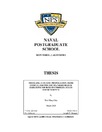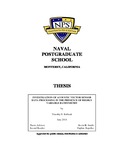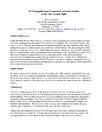MODELING ACOUSTIC PROPAGATION FROM CONICAL SHAPED AND STANDARD BLOCK EXPLOSIVE SOURCES IN COMPLEX OCEAN ENVIRONMENTS
| dc.contributor.advisor | Hooper, Joseph P. | |
| dc.contributor.advisor | Olson, Derek | |
| dc.contributor.author | Chiu, Wei-Ming | |
| dc.date.accessioned | 2020-06-05T16:23:51Z | |
| dc.date.available | 2020-06-05T16:23:51Z | |
| dc.date.issued | 2020-03 | |
| dc.identifier.uri | https://hdl.handle.net/10945/64841 | |
| dc.description.abstract | Detection of underwater explosions by acoustic means, which has been widely researched, is simple, given the large peak pressures produced by these types of sources. By contrast, estimation of the explosive yield and type of explosive by such means has received less attention. This research compares the propagation of acoustic waves in a shallow water waveguide generated by underwater detonations producing broadband impulse signals. Typically, broadband waves are dispersive due to the waveguide in shallow water regions. Data was drawn from experiments conducted near Oahu, Hawai’i, using two explosive sources for different configurations: a conical shaped charge and a standard block. Both sources consisted of Composition C-4 explosive material and were detonated at comparable depths. This thesis focuses on differentiating the propagation of acoustic waves in multiple environments from these two kinds of sources. Simulations were used to explore different seabed properties, which varied by location, and how they impacted peak pressure variability across the Indo-Pacific region. By enhancing the understanding of acoustic propagation of explosive sources in complex environments, this research is helpful in cross domain operations. The developed models can also be applied defensively to determine the optimal placement and number of sensors required to monitor critical infrastructure on the seabed. | en_US |
| dc.description.uri | http://archive.org/details/modelingacoustic1094564841 | |
| dc.publisher | Monterey, CA; Naval Postgraduate School | en_US |
| dc.rights | Copyright is reserved by the copyright owner. | en_US |
| dc.title | MODELING ACOUSTIC PROPAGATION FROM CONICAL SHAPED AND STANDARD BLOCK EXPLOSIVE SOURCES IN COMPLEX OCEAN ENVIRONMENTS | en_US |
| dc.type | Thesis | en_US |
| dc.contributor.department | Oceanography (OC), Engineering Acoustics Academic Committee (EAAC) | |
| dc.subject.author | acoustic propagation | en_US |
| dc.subject.author | waveguide dispersion | en_US |
| dc.subject.author | broadband explosive source | en_US |
| dc.subject.author | underwater ocean environment | en_US |
| dc.subject.author | sedimentation | en_US |
| dc.subject.author | geo-acoustic properties | en_US |
| dc.subject.author | conical shaped charge explosive | en_US |
| dc.subject.author | standard block C-4 | en_US |
| dc.subject.author | normal mode theory | en_US |
| dc.subject.author | data analysis | en_US |
| dc.description.service | Lieutenant, Taiwan Navy | en_US |
| etd.thesisdegree.name | Master of Science in Physical Oceanography, Master of Science in Engineering Acoustics | en_US |
| etd.thesisdegree.level | Masters, Masters | en_US |
| etd.thesisdegree.discipline | Physical Oceanography, Engineering Acoustics | en_US |
| etd.thesisdegree.grantor | Naval Postgraduate School | en_US |
| dc.identifier.thesisid | 32446 | |
| dc.description.distributionstatement | Approved for public release; distribution is unlimited. |
Files in this item
This item appears in the following Collection(s)
-
1. Thesis and Dissertation Collection, all items
Publicly releasable NPS Theses, Dissertations, MBA Professional Reports, Joint Applied Projects, Systems Engineering Project Reports and other NPS degree-earning written works.





